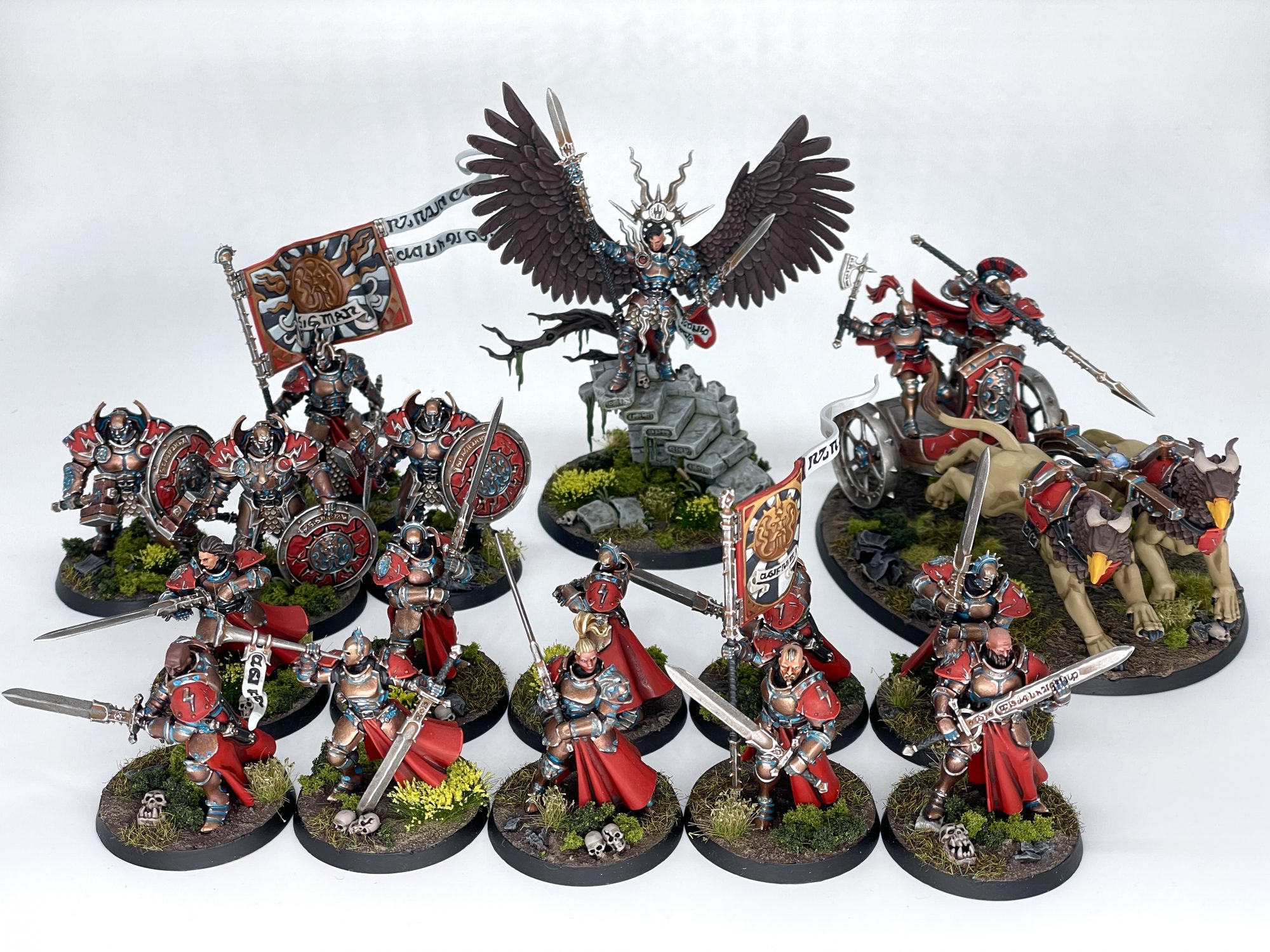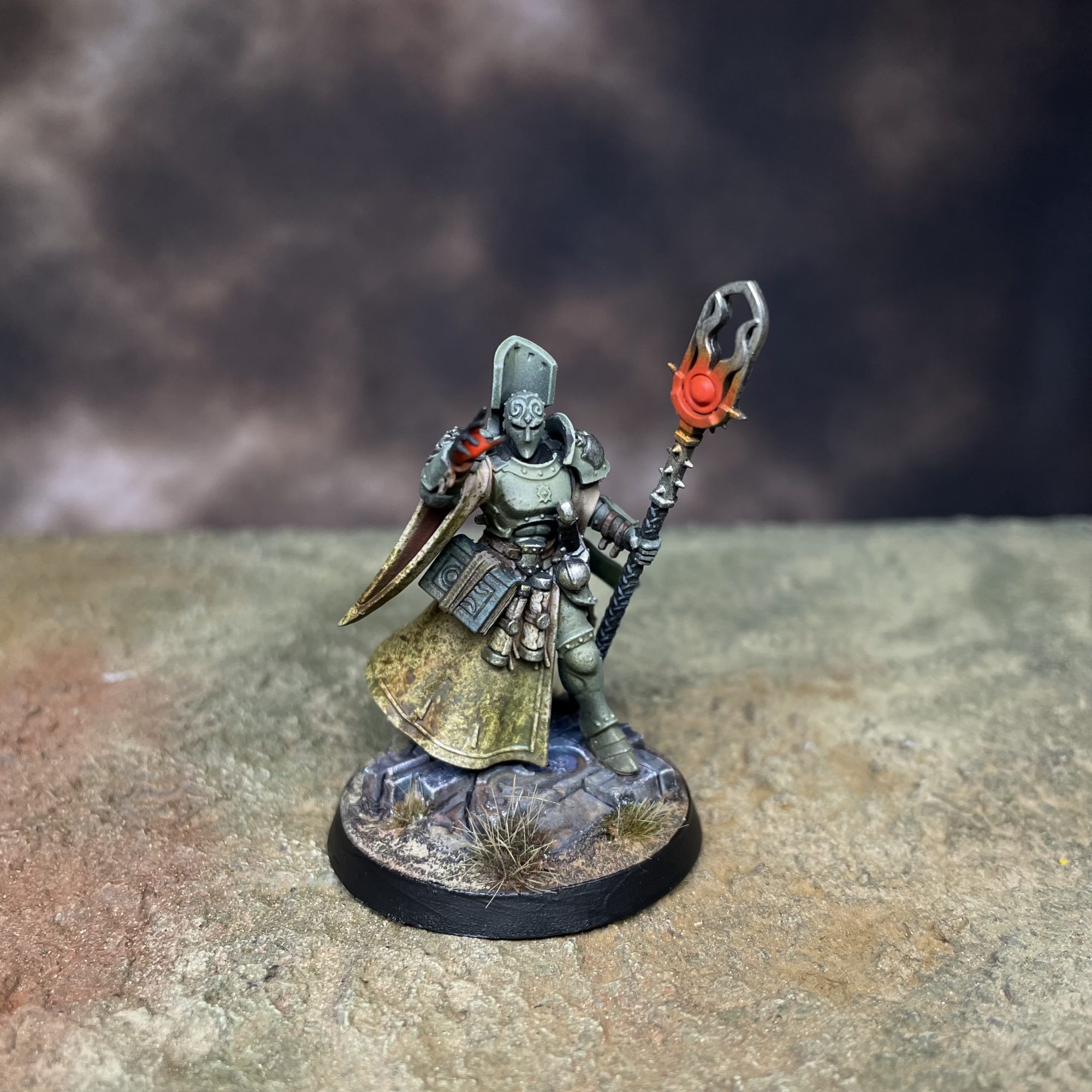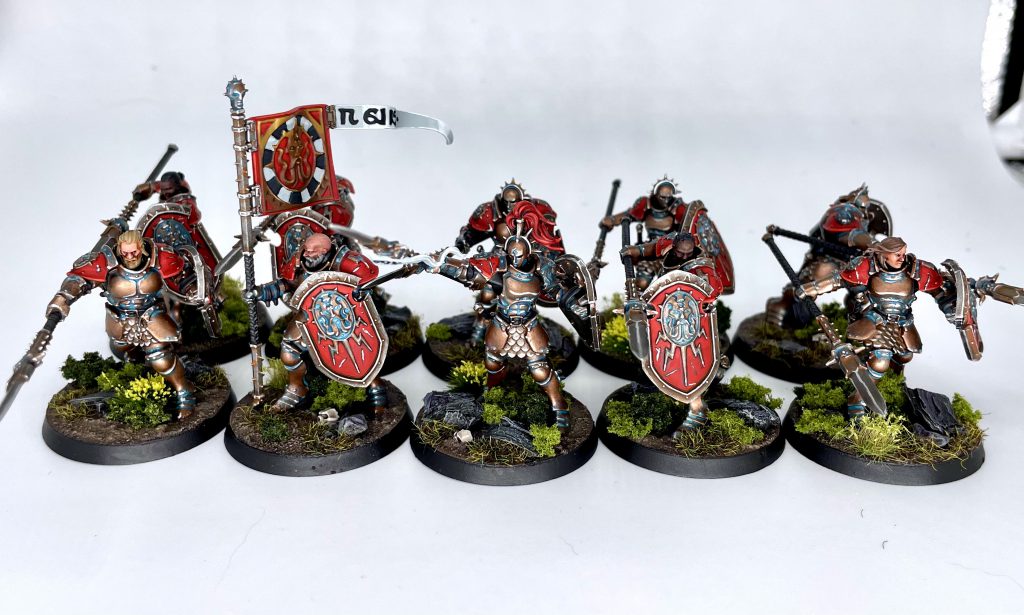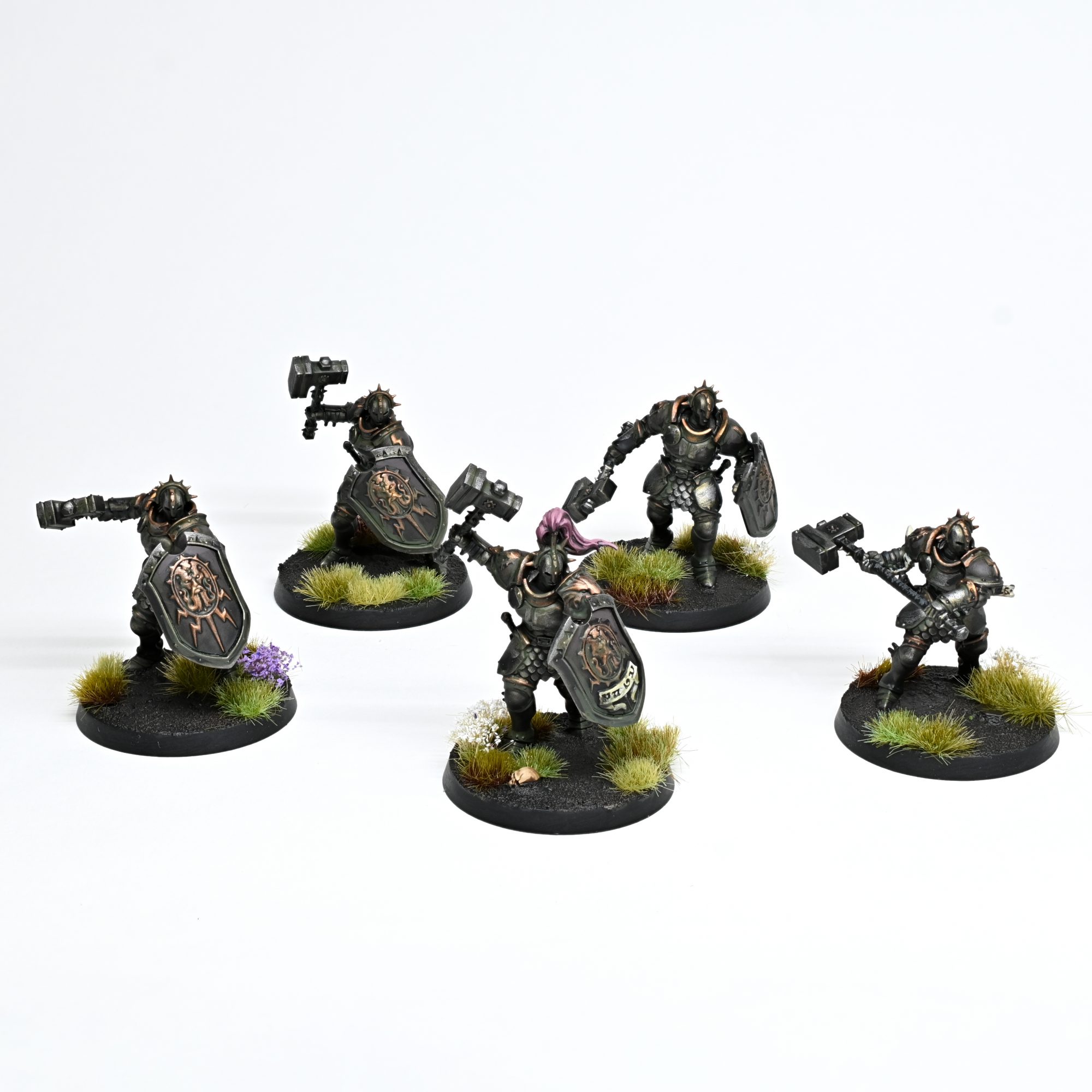Thanks to Games Workshop for sending us these rules and the Skaventide box set for review. Over the coming weeks, we will be having experts provide insight into how they are building and running lists with each faction in Age of Sigmar. For this overview, we’re looking at what stands out for each faction, how much has changed, and how we might approach some key challenges on the tabletop.
The posterchildren of Age of Sigmar, the Stormcast Eternals are Sigmar’s chosen warriors. Forged purely for war, they are the guardians of civilization in the Mortal Realms. Each is doomed to die and be reforged time and again in their endless war against the forces of Chaos, Death, and Destruction.
On the tabletop, they’ve typically been an elite army. Small in number but reasonably durable, they have reasonably strong characters, some banger monsters, and useful support abilities. They still thrive in this archetype, but have a few extra tricks up their Sigmarite-plated sleeves. Despite being slow on-foot, they often have the ability to teleport across the table or deploy their units in bolts of lightning anywhere on the battlefield. They also have a lot of regenerative abilities, healing units and bringing back lost models. It’s an army where each individual unit is solid enough to survive on its own, but by having units support each other, they become stronger than the sum of their already formidable parts.
Army Rules

Battle Traits
Stormcast Eternals have a set of four Battle Traits, available to any Stormcast Eternals army. These should be familiar to anyone who played Stormcast in previous editions, or read more than a few sentences of their lore. They aren’t too exciting and are largely variations on a theme, but they’re easy to get to grips with.
The Celestial Realm/Scions of the Storm
These two Battle Traits are really two parts of the same whole – during deployment, if there are more Stormcast units on the table than in reserves, one can be set up in the Celestial Realm. Scions of the Storm is the second half of this ability, and lets those units deep strike in your movement phase, appearing anywhere on the battlefield more than 9″ away from any enemy units.
Heavens-Sent (1CP)
Once per game in your movement phase, you can select a unit of two or more models and bring it back on the table at half strength (rounding up) for 1 Command Point. This unit also deploys more than 9″ away from any enemy units. Just keep in mind with both of these that any time a unit is set up in the movement phase, it can’t use any more move abilities that turn. This also is distinct from Scions of the Storm, so any abilities that key off that ability won’t have any effect here (sorry, Annihilators).
Their Finest Hour
They went ahead and took this generic Heroic ability from third edition and made it into something every unit in your army can use. Once per turn, in your hero phase, you can pick a unit and give them +1 to save and wound rolls for the rest of the turn. Fortunately, the clocks in Sigmar’s house have Finest Hour printed on them 5 times, so you’ll be buffing one key unit every turn with this. The only caveat is that each unit can only receive this benefit once per game.
Battle Formations
If you’ve read our other articles in this series, you’ll know that specific lore-based subfactions are a thing of the past. In other words, much like 40k’s 10th edition, there’s no longer specific rules for the Hammers of Sigmar or Astral Templars Stormhosts, just a set of more general Battle Formations that inform your army composition and grant them some extra benefits. Some of these benefits seem like stinkers unfortunately, but there’s still some good Battle Formations to go around.
Sentinels of the Bleak Citadels
This one benefits Ruination Chamber units, so most of the shiny new toys from your Skaventide box – your Lords-Veritant, Lords-Vigilant on Gryph-Stalker, Lords-Terminos, Prosecutors, and Reclusians. Once per turn, in the hero phase, give one of these units a 5+ ward save that lasts until the end of the turn. It’s simple, but if you’re leaning in with your new Skaventide box, a 5+ ward save is never unwelcome.
Thunderhead Host
More of a combined arms approach, this Formation gives friendly Warrior Chamber units +1 to hit with combat attacks so long as they’re wholly with 12″ of a non-hero unit without the Warrior Chamber keyword. This mouthful means your squad of Liberators or Vanquishers with the Warrior Chamber keyword will get +1 to hit so long as they’re wholly within 12″ of your Reclusians or Gryph-Hounds. A few key non-Warrior Chamber units could make your whole army reliably hit on 2+ in melee, and a load of those units are good in their own right too. This is a safe bet for any infantry-heavy army.
Vanguard Wing
Once per turn, in your movement phase, you can pick a Vanguard unit that’s not in combat. On a 3+ they can redeploy anywhere else on the battlefield more than 9″ from an enemy unit. There are already units like the Lord-Aquilor that can hand this out to Vanguard Palladors, prayer manifestations that have similar effects, and built in army rules that will let you deep strike units plenty as-is. It’s not reliable enough to count on every turn, and while the mobility is nice, it doesn’t have the staying power of the previous Battle Tactics.
Oncoming Storm
Once per turn, an Extremis Chamber unit that charged gets Fights-First on a 3+. This is all the dragon riders in your army, from Stardrakes to Draconiths, but crucially not Krondys or Karazai. Similar to the Vanguard Wing, picking a single unit once per turn to gain a benefit on a 3+ isn’t incredible, especially when it has to have charged.
Heroic Traits

All of these are handy buffs that you can stick on any non-unique hero in your army, turning even your fightiest beatstick into something of a support character. They’ve all got some play, though the latter Traits are likely the most useful.
Staunch Defender
While contesting an objective in friendly territory, add 3 to the control score for all friendly Stormcast units contesting that same objective. Ideally you’re not fighting over your backfield objectives much, and if you are, you’re probably in trouble. That being said, this will ensure that the objective remains yours.
Shock and Awe
Loaded real-world terminology aside, this grants a -1 to hit defensive benefit for any friendly Stormcast units that set up using the Scions of the Storm wholly within 12″ of the hero unit. Stick this on a far-reaching hero like a Knight Draconis or Lord-Vigilant on Gryph-Stalker so that when your deep strikers come in, they can be somewhere useful while benefiting from this Heroic Trait.
Envoy of the Heavens
If a unit of yours was destroyed last turn, pick a friendly unit wholly within 12″ of your hero and give them a 5+ ward save. Ideally you won’t be losing any full units on the first turn, but part of this game is understanding that your dudes will die. Take advantage of this by making sure your other dudes don’t. There might be some play to set this up with chaff units of Gryph-Hounds, but you’ll definitely find opportunity to use this more often than not. Already tanky units like Stormdrake Guard or Annihilators won’t be going anywhere now.
Artefacts of Power
These are a mix of utility artefacts, none of which will make your hero a killing machine, but might help them accomplish some goal.
Null Pendant
Once per battle, at the end of any turn, you can subtract 5 from the control score of an enemy unit in combat with this hero. This is a very rude way to suddenly flip control of an objective that your opponent thought was theirs. This could be great for taking a key midfield objective from one of their combat units, or sticking on a sneaky hero who wants to flip their home objective. It’s only single use, but that might be enough.
Quicksilver Draught
Once per battle in any combat phase, your hero gains the Strike-First effect. It’s not exciting, but effectively shutting down a counter-charge once per game could be handy with a combat character or monster.
Mirrorshield
The only passive of the bunch, and another returning artefact from the last edition, this artefact prevents your hero from being targeted by shooting attacks from outside 9″. If you have a hero on a Draconith or Stardrake you want to keep alive, a shooting hero like a Knight-Judicator, or any other hero that’s too big to hide, this is a pretty easy choice.
Spell Lore

Stormcast spells are largely debuffs, and they’re pretty nasty for how easy they are to cast.
Lightning Blast
Casting on a 5+, this spell does D3 mortal damage to the closest visible unit that has not already been targeted by this spell. It’s Unlimited which is fine, and the only remarkable thing about it is that you can potentially do some sort of angling to hit a unit on the other side of the board your opponent doesn’t want you to hit. If you want to go through the effort of lining up the perfect pool shot for D3 mortal damage, be my guest.
Thundershock
Pick an enemy unit within 12″, and on a 6+, subtract 1 from wound rolls for their attacks until your next turn. This is a hell of a debuff, and can defang a key combat unit for what will likely feel like an eternity.
Starfall
Here’s another nasty debuff. Target an enemy Infantry or Cavalry unit within 18″ of the Wizard, and on a casting roll of 7+, reduce the number of dice they roll for charges by 1, to a minimum of 1. This could stop that unit of Chosen in their tracks, or protect your objective from a longbomb charge.
Prayer Lore
Befitting the “starter” army, Stormcast prayers are largely simple, straightforward buffs. They have low chanting values, and none will require too much fancy maneuvering to pull off.
Healing Storm
The one Unlimited prayer of the bunch, this prayer chants on a 4+ and heals D3 wounds to a friendly unit wholly within 12″. On an 8+ it can target every friendly Stormcast Eternals unit wholly within 12″, meaning you could very easily set up a big ol’ healing bomb in the middle of your force.
Bless Weapons
A returning prayer from 3rd edition, this chants on a 6+ and gives +1 attack to melee weapons on a unit wholly within 12″. On a chanting roll of 12+, it similarly affects every friendly Stormcast unit wholly within 12″. It might be a smidge harder to set up a 12+ chanting roll, but suddenly increasing the damage output of your entire front line will even make the humble Liberator a real threat.
Translocation
On a 4+, one of your Stormcast units wholly within 12″ gets picked up and put down somewhere else on the battlefield, so long as it’s outside of 9″ of any enemy units. On a big roll of 8+, they’re also at a -1 to hit for the rest of the battle round. Note that this is not the Scions of the Storm ability, so your Annihilators won’t get to keep doing mortal damage bombs. Still, yeeting your somewhat slow 5″ moving units across the table is huge for mobility, helping you nab objectives or pull a unit out of combat and get them to safety. The -1 to hit debuff is nice, but saving those ritual points for more prayers later on will probably be more important.
Manifestations
These are the new name for Endless Spells, and there can only be one of each in your army at a time. These can now also be directly interacted with, so if someone really wants to dispell your Everblaze Comet, they can just hit it with a hammer. These spells deal middling damage, but have a load of value as buff and debuff tools.
Dais Arcanum
Flying discs aren’t just for Tzeentch anymore – simply manifest this spell on a 6+ and one of your friendly Hero units within 12″ gets to fly around like the kids in the Crossfire commercial. Said unit gets a 5+ Ward save, can cast an extra spell if they’re a Wizard, and their movement is now 8″ with the Fly keyword. This does mean your Hero will have trouble staying in cover, but will help them cast spells and get into position better than ever.
Celestian Vortex
The humble Hammernado manifests on a 6+, appearing within 18″ of the caster but 9″ away from enemy units. While it puts out a dozen fairly low quality and inaccurate attacks, it crucially reduces hit rolls of 1 for enemy shooting attacks within 12″ of it. If you drop this in front of a Cities of Sigmar or Lumineth gunline, it might buy you the time to survive their fusillade.
Everblaze Comet
This magic space rock manifests on a 7+ anywhere within 18″ of the caster. Roll a D3 for any enemy units within 6″ of it and on a 2+, do that many mortal wounds. A couple mortal wounds here and there aren’t amazing, but it does subtract 1 from casting rolls for enemy Wizards within 12″, which might be the nudge it takes to keep some key spells from going off or bother a magic-heavy army.
Warscroll Spotlights

There’s simply too many Warscrolls for us to cover in this article, but we thought we’d break down a few of the exciting and important units in the army.
Liberators, Vanquishers, and Vindictors
These are essentially three variations on a theme; they’ve all got the same stat block (move 5″, 2 health, 3+ save, 1 control, 2 melee attacks at 3+ to hit and wound, with 1 damage and 1 rend) with some key tweak that makes them slightly different. Liberators are better at holding objectives in your territory, gaining 3 to their control score in your territory. They also do mortal wounds on crits. You want them in your backfield screening out deep strikers and defending your home objectives. Vindictors are instead meant to be your shield wall, with Anti-charge (+1 Rend) on their Stormspears and gaining the Strike-First rule on a 4+ any time they get charged. Vanquishers are the choppiest of the crew, with Anti-Infantry (+1 Rend) on their Celestial Greatswords, which go up to Damage 2 against units of 5 or more models. You’ll likely have some combination of these three fairly similar units, and using each for their specific role will help you get the most out of them.
Lord-Terminos
The Lord-Terminos on his own hits like a reasonably sized truck, with four pretty high quality attacks that can even spike some mortals. Where he really shines is as a support character for Ruination Chamber units like your Reclusians and Prosecutors. He buffs their control scores by 3 so long as his Memorian is alive, and after he uses a Fight ability, you can immediately pick another unit with the Ruination Chamber keyword to fight after him. When they do so, they have +1 to hit for the rest of the turn, suddenly making them that much more effective. All units with the Ruination Chamber rule also get a special resistance roll. Once per turn, a single Ruination Chamber unit from your army can just flat out ignore any non-core ability that targets them on a 4+. That won’t work on a normal Core ability like an attack, but can shut down a spell, prayer, or other special ability that targets them. It’s not reliable enough to count on, but if you’re going to be using those cool new models from Skaventide, you’ll want to keep that rule in mind.
Krondys, Son of Dracothion
The only Wizard (2) in the army is also an absolute monster in melee, has a decent shooting attack, has access to a bunch of useful support abilities, and a great Warscroll spell. Before mulching a unit in combat, he can shut down their ability to receive commands on a 3+. His Atavistic Tempest spell (casting value 8+, but he gets +2 to all casting rolls so it’s really a 6+) lets him reach out and debuff an enemy unit within 18″, subtracting 1 from hit rolls, save rolls, or their Rend characteristic. He could stack this with Thundershock from the Stormcast Spell Lore to shut down an enemy unit, provided he doesn’t kill them first.
Stormdrake Guard
These terrors of third edition still have some teeth. They’re a real melee threat, with a healthy bucket of wounds, 12″ move, the Fly keyword, and some half decent shooting. The real fun begins in the combat phase, where on a 3+, they can immediately move 2D6″ through enemy units and end that move in combat – but crucially do not have to. They cause D3 mortal damage to a unit they pass over, but the ability to slingshot a unit of these across the table onto objectives, into vulnerable units, or past screening units is huge.
Prosecutors
As one of only two units (the other being Yndrasta) with the ability to charge 3D6″, these guys are immediately attention grabbing. They have the same Ruination Chamber rule as the Reclusians, and a bonus to damage on the charge which should make them reasonably good at clearing screens or charging those backfield units your opponent really doesn’t want in combat. Use them as a fast skirmisher unit and take advantage of their unusually good mobility and threat range – just don’t count too much on their shooting.
Ride the Lightning
Stormcast Eternals are never going to be the wildest army in the game. As the de facto face of Age of Sigmar, they’ve got to be a reasonable baseline that the weirder armies can be compared to. That said, they still have some fun synergies and interesting units. It’s an army durable enough that beginners can make some mistakes and still bounce back, but there are enough tools in Sigmar’s toolbox to keep more seasoned players experimenting. If you’re one of those very veterans, you’ll find this army works an awful lot like it used to, and your reforged friends will be waging war as you expect in the new edition.
Have any questions or feedback? Drop us a note in the comments below or email us at contact@goonhammer.com. Want articles like this linked in your inbox every Monday morning? Sign up for our newsletter. And don’t forget that you can support us on Patreon for backer rewards like early video content, Administratum access, an ad-free experience on our website and more.




